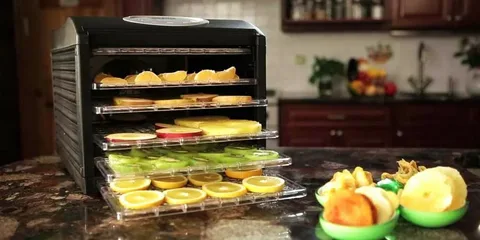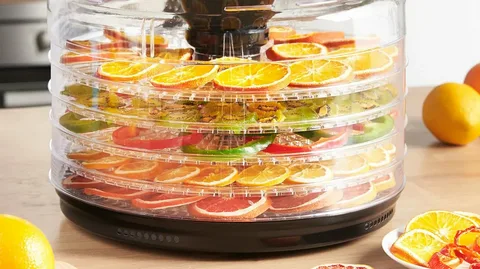Are you looking for a way to preserve your favourite fruits, vegetables, and meats while creating delicious and healthy snacks at home? Look no further than a food dehydrator. This handy kitchen appliance lets you dehydrate food, removing moisture to extend its shelf life without compromising its nutritional value. In this blog post, we will explore the art of preservation with a food dehydrator and how you can master this technique in your home.
Understanding the Basics of Food Dehydration
Food dehydration is a timeless preservation method that relies on the simple principle of removing moisture from food. This process is critical because moisture is where bacteria, mould, and yeast thrive, leading to food spoilage. By extracting water, food dehydration effectively slows down these organisms’ ability to grow, thereby prolonging the shelf life of the food.
Utilizing a food desiccator, this method employs a controlled environment where warm air circulates the food. The appliance gently heats the food, allowing moisture to evaporate, while the fan ensures uniform drying by evenly distributing the warm air. This meticulous process ensures the food dries thoroughly without being cooked, preserving its original flavours and nutrients. The beauty of food dehydration lies in its simplicity and the minimal impact on the food’s nutritional content.
Unlike other preservation techniques that may diminish the food’s nutritional value, dehydration maintains most of the vitamins, minerals, and enzymes present in the food. It’s an effective way to store food for long periods while retaining its health benefits. Understanding this basic yet crucial process sets the foundation for successfully preserving various foods using a food desiccator, from juicy fruits to savoury meats.
The Versatility of a Food Desiccator
A food desiccator shines in its ability to handle an impressive array of food types, making it an indispensable tool for culinary experimentation and preservation. From the crisp, tangy sweetness of dehydrated apple rings to the rich, savoury chew of homemade beef jerky, the range of snacks and ingredients you can produce is nearly limitless. This flexibility extends beyond just fruits and meats; vegetables can be transformed into crunchy chips or used as ingredients in soups and stews, herbs can be dried year-round for seasoning, and even flowers can be dehydrated for teas or crafting.
Each category of food benefits from the gentle drying process, which concentrates flavors and allows for creative seasoning opportunities. Imagine infusing your fruits with a hint of cinnamon or giving your jerky a spicy kick with a custom blend of spices. The food desiccator encourages you to explore different taste profiles and textures, offering a playground for those who love to tweak and innovate in their culinary creations.
Moreover, the simplicity of the process means that even novices can achieve consistent, high-quality results with minimal effort. Whether you aim to stock your pantry with healthy snacks or add a new dimension to your cooking, the food desiccator provides the versatility needed to expand your culinary repertoire.
Health Benefits of Food Dehydrators
Dehydrating food with a food desiccator offers many health advantages, particularly when preserving the natural goodness contained within our favourite snacks. One of the most significant benefits is the concentration of nutrients that occurs when moisture is removed. This process can increase the density of vitamins, minerals, and antioxidants in fruits and vegetables, making each bite more nutrient-rich than their fresh counterparts. Additionally, dehydrated foods lack the added sugars, sodium, and preservatives often found in commercially available snacks, promoting a cleaner diet.
Fibre, an essential component of a healthy diet, remains intact and, in some cases, is more concentrated in dehydrated foods. This can aid in digestion and promote satiety, helping to reduce overeating. For those maintaining an active lifestyle or looking to increase their protein intake, dehydrated meats provide a convenient, portable source of protein. They offer a satisfying alternative to processed snacks, which can be high in unhealthy fats and additives.
Furthermore, dehydrating food at home allows for complete control over ingredients, enabling individuals to cater to dietary restrictions or preferences. Whether creating gluten-free snacks or ensuring your diet is free from artificial additives, food dehydrators empowers you to make healthier choices. Embracing a food desiccator elevates the nutritional profile of your pantry and aligns with a mindful approach to eating and snacking.
How to Choose the Right Food desiccator for Your Home
Selecting the ideal food desiccator for your household hinges on understanding your specific needs and preferences. The market offers various models with various features, but focusing on a few key aspects can guide you to the perfect choice. Consider the capacity you require; if you plan to dehydrate large batches of food, a dehydrator with ample space or expandable trays will serve you best. For those with limited kitchen space, compact models are available that maintain efficiency.
Price is another important factor, but balancing cost with quality is wise. Investing in a slightly higher-priced dehydrator might provide more consistent results and durability. Features such as adjustable temperature settings are crucial for successfully dehydrating different types of food, as they allow for precise control over the drying process. A model with a range of temperatures can accommodate everything from herbs that need low heat to meats that require higher temperatures.
Additionally, consider ease of use and maintenance. Models with dishwasher-safe trays simplify cleanup, and those with a digital control panel offer convenience and accuracy. Lastly, an automatic shut-off feature or a timer can enhance safety and prevent over-drying, preserving the quality of your food. By carefully evaluating these factors, you can select a food desiccator that meets your culinary needs and enhances your food preservation endeavors.
Tips and Tricks for Successful Food Dehydration
Achieving optimal results using a food desiccator involves adopting a few strategic practices. Begin by selecting high-quality, ripe produce and fresh meats, as the quality of your ingredients will directly influence the taste and nutritional value of the dehydrated product. Pre-treatment is another key step; blanching vegetables before dehydrating can preserve colour and reduce spoilage, while dipping fruits in lemon juice or an ascorbic acid solution can prevent browning.
 Thickness and uniformity in slicing are crucial for even drying. Aim for consistent slice thickness across all dehydrated items, as varying thicknesses can lead to uneven drying times. Marination can elevate the flavour profile of meats significantly. Opt for lean cuts to reduce drying time and ensure a better texture in the final product.
Thickness and uniformity in slicing are crucial for even drying. Aim for consistent slice thickness across all dehydrated items, as varying thicknesses can lead to uneven drying times. Marination can elevate the flavour profile of meats significantly. Opt for lean cuts to reduce drying time and ensure a better texture in the final product.
Spacing is also important; arrange slices in a single layer without overlap for adequate air circulation. Pay close attention to drying times and temperatures specific to the type of food you are dehydrating. Over- or under-dehydrating can negatively affect both texture and flavor.
Lastly, storage plays a critical role in preserving the longevity of dehydrated foods. After dehydration, allow your foods to cool to room temperature before packing them into airtight containers. Storing them in a cool, dark place can further extend their shelf life. Adhering to these guidelines can enhance your dehydrating experience and enjoy superior results.
The Energy Efficiency of the Best Food Dehydrator
In today’s eco-conscious world, selecting a best food dehydrator that maximizes energy efficiency is a smart choice for the environment and your wallet. The best food desiccators on the market are engineered with energy savings in mind, employing advanced technologies to minimize electricity usage without compromising performance. These models often feature highly efficient heating elements and fans that circulate air effectively, ensuring that food dries evenly and quickly, thereby reducing operational times.
Additionally, many of these energy-efficient dehydrators are equipped with programmable timers, which allow users to set specific drying times, automatically turning the device off once the process is complete. This prevents over-drying and conserves energy by ensuring the dehydrator operates only as long as necessary. Another aspect to consider is the insulation of the dehydrator; well-insulated models retain heat better, decreasing the energy required to maintain the optimal drying temperature.
By prioritizing energy efficiency when choosing a food desiccator, you contribute to a more sustainable lifestyle while enjoying the benefits of home-preserved foods. Opting for a model with these energy-saving features reflects a commitment to reducing energy consumption, underscoring the importance of sustainability in our daily culinary practices.
Maintenance and Care of Your Food desiccator
Keeping your food desiccator in prime condition ensures its longevity and performance. Immediately following each use, disassemble any removable components, such as trays and doors, washing them in warm water and mild detergent. This step helps to remove any food residues that could harbour bacteria or cause unpleasant odours. Rinse these parts thoroughly and let them air dry completely before reassembling the unit.
For the interior, a damp cloth can be used to wipe down surfaces, taking care not to immerse the main body of the dehydrator in water, as this could damage the electrical components. It is also important to inspect the fan and heating element regularly for dust and food particles; these can be gently brushed away or vacuumed with a small attachment to maintain optimal airflow and heating efficiency.
Should any parts of your dehydrator become worn or damaged, consult the manufacturer’s guidelines on obtaining suitable replacements. This not only ensures that your appliance continues to function as intended but also prevents safety hazards. By adhering to these simple maintenance and care practices, you’ll ensure that your food desiccator remains a reliable tool in your culinary arsenal for years.
FAQs
1. Can I dehydrate different types of food at the same time?
Yes, you can simultaneously dehydrate various food types in a food desiccator if they require a similar temperature setting. However, be mindful of flavor transfer; foods with strong aromas may impart their flavor onto others. To avoid this, dehydrate strong-smelling foods separately.
2. How long do dehydrated foods last?
The shelf life of dehydrated foods depends on several factors including the type of food, dehydration method, and storage conditions. Properly dried, stored in airtight containers, and kept in a cool, dark place, dehydrated foods can last for months and up to a year. Moisture-absorbing packets can extend shelf life further.
3. Is it necessary to pre-treat foods before dehydrating them?
While not always necessary, pre-treating certain foods can improve colour, flavour, and safety. Blanching vegetables helps to halt enzyme action that can cause spoilage, and dipping fruits in lemon juice or an ascorbic acid solution can prevent browning. Pre-treating meat with a marinade can enhance flavour and tenderize it before dehydration.
Conclusion
In conclusion, mastering food dehydration is both an enjoyable and beneficial endeavor. It invites you to discover the delicate balance of moisture content that best preserves your favourite foods’ flavour and nutritional value. With patience and practice, you’ll find yourself adept at creating an array of dehydrated delicacies. We encourage you to start this journey today, letting the humble food dehydrator revolutionize how you think about snack preparation and food preservation. The path to healthier, homemade snacks is not only rewarding but also a testament to the enduring appeal of preserved foods in our diets. Happy dehydrating!
| Other Good Articles to Read |
| Niche Blogs Connect |
| Blogs 97 |
| Blog Stitution |
| Blogs Unplugged |
| Blogs Cotch Rouge |
| Blog Signatr |
| Blog Sintonias |
| Blog Zilla |
| Consumer Forums |
| Finance Forums |
| G Blogs |
| Too Blog |
| Related Business Listings |
| Contact Directory |
| Local Business Profiles |



